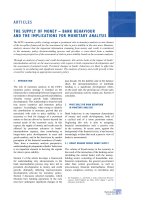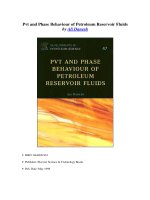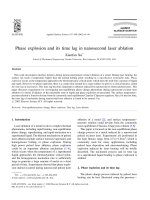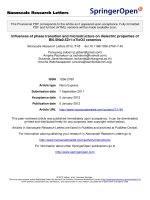Phase behaviour and rheology of solutions of associative polymer and surfactant
Bạn đang xem bản rút gọn của tài liệu. Xem và tải ngay bản đầy đủ của tài liệu tại đây (1.36 MB, 128 trang )
PHASE BEHAVIOR AND RHEOLOGY OF SOLUTIONS
OF ASSOCIATIVE POLYMER AND SURFACTANT
ZHAO GUANGQIANG
NATIONAL UNIVERSITY OF SINGAPORE
2007
PHASE BEHAVIOR AND RHEOLOGY OF SOLUTIONS
OF ASSOCIATIVE POLYMER AND SURFACTANT
ZHAO GUANGQIANG
(B.ENG., SHANGHAI JIAOTONG UNIVERSITY)
A THESIS SUBMITTED
FOR THE DEGREE OF DOCTOR OF PHILOSOPHY
DEPARTMENT OF CHEMICAL AND BIOMOLECULAR
ENGINEERING
NATIONAL UNIVERSITY OF SINGAPORE
2007
Acknowledgement
ACKNOWLEDGEMENT
This dissertation represents the successful culmination of many years of hard
and deliberate work on a chemical engineering research project that would not have
been possible without the efforts of many other people on my behalf.
In particular, I am indebted to Professor Chen Shing Bor for his constant
guidance and inspiration throughout my graduate study. I could always count on
him to help me see things from another point of view, and to foster both my
professional and personal development.
I would also like to thank my oral qualifying examination committee members,
Professor
Chung Tai-Shung, Neal and Professor Uddin, Mohammad S. for their
genuine comments on my research and valuable advice on how to be a good scientist.
This work has received a great deal of support and assistance from the lab
officers Ms. Siew Woon Chee, Ms. Sylvia Wan and Ms. Chew Su Mei. I would like to
acknowledge Ms. Samantha Fam and Dr. Yuan Ze Liang for their help on the
operation of the laser scattering system in the initial stage of this project.
Many thanks also go to my labmates: Mr. Zhou Tong, Ms. Cho Cho Khin, Mr.
Gao Yonggang, Ms. Zhou Huai, Ms. Shen Yiran and Ms. Chieng Yu Yuan, for their
support and helpful discussions. Without them, the atmosphere in the lab would not
have been so unforgettable. Thanks are also due to my friends at NUS, Mr. Zhu Zhen,
Mr. Shao Lichun, Ms. Sheng Xiaoxia, and Mr. Chen Huan for their encouragement
and enjoyable talks and jokes during the numerous afternoon tea sessions.
Finally, I express my heartful gratitude to my parents, whose support made me
strong in facing with difficulties, and to my wife, who supported me through all of the
lean times, both physical and emotional.
ii
Table of Contents
TABLE OF CONTENTS
ACKNOWLEDGEMENT ii
TABLE OF CONTENTS iii
SUMMARY v
LIST OF FIGURES viii
LIST OF TABLES xiii
NOMENCLATURE xiv
CHAPTER 1 Introduction to Associative Polymers and Surfactants 1
1.1 Motivation for Study of Associative Polymers 1
1.2 Definition of an Associative Polymer 1
1.3 Interactions with Surfactants 2
1.3.1 Clouding Phenomenon and Phase Separation 2
1.3.2 Rheological Aspect 4
1.3.3 Microrheology 6
1.4 Objectives and Scope of This Work 6
1.5 Organization 7
CHAPTER 2 Materials and Methods 9
2.1 Investigated Associative Polymer (HMHEC) 9
2.2 Control Polymer (HEC) 10
2.3 Nonionic Surfactants 11
2.4 Experimental Methods 13
2.4.1 Sample Preparation 13
2.4.2 Cloud Point Measurement 13
2.4.3 Phase Separation 14
2.4.4 Composition Analysis 14
2.4.5 Rheological Characterization 16
2.4.6 Conductivity Measurement
19
CHAPTER 3 Clouding and Phase Behavior of Nonionic Surfactants in
HMHEC Solutions
21
3.1 Early Investigations into the Phase Behavior 21
3.1.1 Neutral Polymer/Surfactant Mixtures 22
3.1.2 Associative Polymer/Surfactant Mixtures 23
3.2 Results and Discussion 25
3.2.1 CPT curves of nonionic surfactant with polymer 25
3.2.2 Two-Phase Separation 28
3.2.3 Three-Phase Separation 35
363.2.3.1 Composition analysis by TOC method
383.2.3.2 Phase Separation Kinetics
413.2.3.3 Phase Volume Fraction
463.2.3.4 Composition Analysis by Anthrone Method
3.3 Conclusions 51
iii
Table of Contents
CHAPTER 4 Nonionic Surfactant and Temperature Effects on the Viscosity
of Hydrophobically Modified Hydroxyethyl Cellulose Solutions
53
4.1 Literature Review 53
4.2 Results and Discussion 54
4.2.1 Temperature Effect on Pure HMHEC Solutions 54
4.2.2 Clouding Behavior of HMHEC-Surfactant Solutions. 58
4.2.3 Viscosity Behavior of HMHEC-Surfactant Solutions 61
4.2.4 Comparison with the System of Charged HMP 68
4.3 Conclusions 69
CHAPTER 5 Nonlinear Rheology of Aqueous Solutions of HMHEC with
Nonionic Surfactant
70
5.1 Early Investigations Relevant to this Study 70
5.2 Results and Discussion 71
5.2.1 Absence of Surfactant 71
715.2.1.1 Steady Shear Behavior
755.2.1.2 Dynamic Oscillatory Shear Behavior
785.2.1.3 Temperature Effect on Shear Thickening
5.2.2 Presence of Nonionic Surfactant 80
5.3 Conclusions 87
CHAPTER 6 Microrheology of HMHEC Aqueous Solutions 89
6.1 Literature Review 89
6.2 Results and Discussion 91
6.2.1 Absence of Polymer 91
6.2.2 Presence of Polymer 92
6.2.3 Comparison between Microviscosity and Bulk Viscosity 97
6.3 Conclusions 100
CHAPTER 7 Conclusions and Recommendations for Further Research 101
7.1 Conclusions 101
7.2 Recommendations for Further Research 102
References 104
PUBLICATIONS 110
iv
Summary
SUMMARY
To elucidate the interactions between associative polymers and surfactants, we
studied the phase behavior and rheological properties of their aqueous mixtures. In
particular, clouding phenomena, phase separation behavior, steady and dynamic shear
viscosity, and nonlinear rheology were examined for mixtures of hydrophobically
modified hydroxyethyl cellulose (HMHEC) and nonionic surfactants.
Two nonionic surfactants, Triton X-114 and Triton X-100, in the presence of
either hydroxyethyl cellulose (HEC) or the hydrophobically modified counterpart
(HMHEC) were used to experimentally study the clouding phenomena and phase
behaviors. Compared with HEC, HMHEC was found to have a stronger effect on
lowering the cloud point temperature (CPT) of nonionic surfactant at low
concentrations. The difference in clouding behavior can be attributed to different
kinds of molecular interactions. Depletion flocculation is the underlying mechanism
in the case of HEC, while chain-bridging effect is responsible for the large decrease in
CPT for HMHEC. Composition analyses of the formed macroscopic phases were
carried out to provide support for associative phase separation in the case of HMHEC,
in contrast to segregative phase separation for HEC. An interesting three-phase
separation phenomenon was reported for the first time in some HMHEC/Triton X-100
mixtures at high enough surfactant concentrations.
The interesting three-phase separation for Triton X-114 or Triton X-100
solutions with addition of hydrophobically modified hydroxyethyl cellulose was then
investigated in detail experimentally. When the surfactant concentration was high
enough, the solution slightly above the cloud point could separate into three
macroscopic phases: a cloudy phase in between a clear phase and a bluish, translucent
phase. The rate of phase separation was very slow in a matter of several days with the
formation of the clear and cloudy phases followed by the emergence of the bluish
phase. The volume fraction of the cloudy phase increases linearly with the global
polymer concentration, while the volume fraction of the bluish phase increases
linearly with the global surfactant concentration. Composition analyses found that
v
Summary
most of the polymer stayed in the cloudy phase, as opposed to most of surfactant in
the bluish phase. The interesting phase behavior can be explained by an initial
associative phase separation followed by a segregative phase separation in the cloudy
phase.
The viscosity behavior of HMHEC solutions were investigated experimentally,
focusing on nonionic surfactant and temperature effects. Weak shear thickening at
intermediate shear rates took place for HMHEC at moderate concentrations, and
became more significant at lower temperatures. While this amphiphilic polymer in
surfactant free solution did not turn turbid by heating up to 95 °C, its mixture with
nonionic surfactant showed a lower cloud point temperature than did a pure surfactant
solution. For some mixture cases, phase separation took place at temperatures as low
as 2 °C. The drop of cloud point temperature was attributed to an additional attractive
interaction between mixed micelles via chain bridging. With increasing temperature,
the viscosity of a HMHEC-surfactant mixture in aqueous solution first decreased, but
then rose considerably until around the cloud point. The observed viscosity increase
could be explained by the interchain association due to micellar aggregation.
Shear thickening and strain hardening behavior of HMHEC solutions were
experimentally examined. We focused on the effects of polymer concentration,
temperature and addition of nonionic surfactant. It was found that HMHEC showed
stronger shear thickening at intermediate shear rates in a certain concentration range.
In this range, the zero-shear viscosity scaled with polymer concentration as
η
0
~ c
5.7
,
showing a stronger concentration dependence than for more concentrated solutions.
The critical shear stress for complete disruption of the transient network followed
τ
c
~
c
1.62
in the concentrated regime. Dynamic oscillatory tests of the transient network on
addition of surfactants showed that the enhanced zero-shear viscosity was due to an
increase in the network junction strength, rather than their number, which in fact
decreases. The reduction in the junction number could partly explain the weak
variation of strain hardening extent for low surfactant concentrations, because of
longer and looser bridging chain segments, and hence lesser nonlinear chain
vi
Summary
stretching.
The microviscosity of HMHEC aqueous solution was experimentally measured
by conductometry. The microviscosity was significantly lower by more than 4 orders
of magnitude than its bulk viscosity. The hydrophobic modification was found to have
no effect on the solutions’ microviscosity, based on the fact that the same electric
conductivity reduction of a simple salt NaCl was found for both HMHEC and HEC
solutions. This interesting result was explained by the fact that the conductivity
reduction is merely resulted from the hydrodynamic interactions between the probe
ions and the polymer segments.
vii
List of Figures
LIST OF FIGURES
Figure 1.1: A schematic representation of the the mixed micelles formed by the
surfactant molecules and the hydrophobes from the associative polymer 2
Figure 2.1: A schematic representation of the comb-like molecular structure. 9
Figure 2.2: The molecular structure of hydrophobically modified hydroxyethyl
cellulose, with the hydrophobic groups being -C
16
linear alkyl chains. 10
Figure 2.3: GC-MS results for the number fraction of TX100 molecules as a function of
the number of ethylene oxide (EO) repeating units.
12
Figure 2.4: Calibration curves for the interference of Triton X-100 on the absorbance at
626 nm for HMHEC in the anthrone method. The HMHEC concentrations
from bottom to top are 100, 200, 300 and 400 ppm, respectively.
16
Figure 2.5: Diagrammatic representation of a cone-and-plate fixture used for
rheological tests.
17
Figure 2.6: Diagrammatic representation of a double gap fixture used for rheological
tests.
17
Figure 2.7: Sinusoidal wave forms for stress and strain functions in typical dynamic
oscillatory shear test.
18
Figure 3.1: Schematic representation of the chains of PEO bridging two micelles. The
spheres are the micelles (or the hydrophobic core).
55
24
Figure 3.2: Cloud point temperature of TX114 with addition of (a) 0.1 wt% HEC or
HMHEC; (b) 0.2 wt% HEC or HMHEC.
26
Figure 3.3: Cloud point temperature of TX100 with addition of (a) 0.1 wt% HEC or
HMHEC; (b) 0.2 wt% HEC or HMHEC.
27
Figure 3.4: Volume fraction of the macroscopic heavy phase for (a) TX114 solutions, (b)
TX100 solutions, in the presence of HEC.
30
Figure 3.5: Concentration of surfactant in the top clear phase (open symbols) and the
bottom clear bluish phase (closed symbols) after separation for mixtures
with 0.2 wt% HEC; (a) TX114, (b) TX100.
31
Figure 3.6: Concentration of HEC in the top phase for TX114 solutions with addition of
HEC.
32
Figure 3.7: Volume fraction of the macroscopic heavy phase for (a) TX114 solutions; (b)
TX100 solutions, in the presence of HMHEC.
33
Figure 3.8: Concentration of surfactant in the top clear phase (open symbols) and the
bottom cloudy phase (closed symbols) for 0.2 wt% HMHEC; (a) TX114, (b)
TX100.
35
viii
List of Figures
Figure 3.9: A photo showing the three coexisting macroscopic phases for the sample of
0.2 wt% HMHEC+4 wt% TX100 37
Figure 3.10. Evolution of phase volume ratio for four samples at 6 wt% TX100 and
different HMHEC concentrations: 0.0 wt% (top left), 0.1wt% (top right),
0.3wt% (bottom left), 0.5wt% (bottom right). The temperature is 70 °C.
.39
Figure 3.11: Evolution of phase volume ratio for four samples at 6 wt% TX114 and
different HMHEC concentrations: 0.0 wt% (top left), 0.1wt% (top right),
0.3wt% (bottom left), 0.5wt% (bottom right). The temperature is 35 °C.
.40
Figure 3.12: A photo of the three-phase separation for 6 wt% TX114 and HMHEC at
various concentrations: 0, 0.05, 0.1, 0.2, 0.3, 0.4, and 0.5 wt% (from left to
right). The picture was taken after 7 days at 35 °C, when the individual
phase heights no longer changed (except for the first two samples from the
right).
41
Figure 3.13: The volume fraction of (a) the bluish (bottom) phase and (b) the cloudy
(middle) phase versus the global surfactant concentration normalized by the
surfactant’s cmc for HMHEC/TX100 mixtures at 75 °C after 7 days. The
volume fraction of the bluish phase for the pure surfactant solutions after
phase separation was also included for comparison.
43
Figure 3.14: The volume fraction of (a) the bluish (bottom) phase and (b) the cloudy
(middle) phase versus the global surfactant concentration normalized by the
surfactant’s cmc for HMHEC/TX114 mixtures at 35 °C after 7 days. The
volume fraction of the bluish phase for the pure surfactant solutions after
phase separation was also included for comparison.
44
Figure 3.15: The volume fractions of the bluish (bottom) phase and the cloudy (middle)
phase versus the global HMHEC concentration for 6 wt% TX100 at 75 °C
after 7 days.
45
Figure 3.16: The volume fractions of the bluish (bottom) phase and the cloudy (middle)
phase versus the global HMHEC concentration for 6 wt% TX114 at 35 °C.
The measurement was done after 7 days except for the two samples at
0.4wt% and 0.5wt% HMHEC, which were analyzed on the 10th day due to
their slower separation process.
45
Figure 3.17: TX114 concentrations in the separated phases versus the global HMHEC
concentration for the global TX114 concentration fixed at 6 wt%. The
analysis was done at 35 °C after 7 days, except for the sample of 0.4wt%
HMHEC done after 10 days. For 0.05 wt% and 0.1 wt% HMHEC, the
middle phases were too small to be extracted for analysis.
49
Figure 4.1: Steady-state flow curve of pure 0.4 wt% HMHEC at various temperatures.
56
Figure 4.2: Steady-state flow curves of pure 1 wt% HMHEC solutions at various
ix
List of Figures
temperatures 57
Figure 4.3: Arrhenius plots of zero-shear viscosity of pure 0.4 wt% (square) and 1 wt%
(triangle) HMHEC solutions. The slopes of the fitting lines are shown as
well.
58
Figure 4.4: Cloud point temperature of 1 wt% surfactant solutions with addition of
HMHEC; C
12
E
5
(triangles), C
12
E
6
(squares) 59
Figure 4.5: Cloud point temperature as a function of C
12
E
5
concentration without
HMHEC and with 0.4 wt% HMHEC. For the latter, macroscopic phase
separation occurred even at 2 °C (lowest temperature investigated) in the
region between the dashed lines.
60
Figure 4.6: Cloud point temperature as a function of C
12
E
6
concentration without
HMHEC and with 0.4 wt% HMHEC. For the latter, macroscopic phase
separation occurred even at 2 °C (lowest temperature investigated) in the
region between the dashed lines.
60
Figure 4.7: Cloud point Zero-shear viscosity of 1.0 wt% HMHEC with addition of
nonionic surfactant as a function of surfactant concentration at 5 °C. The
short horizontal line indicates the value in the absence of surfactant.
62
Figure 4.8: Zero-shear viscosity of 0.4 wt% HMHEC with addition of nonionic
surfactant as a function of surfactant concentration at 5 °C. The short
horizontal line indicates the value in the absence of the surfactant.
62
Figure 4.9: Temperature dependence of zero-shear viscosity for (a) 0.4wt% HMHEC
+1.8 wt% C
12
E
5
, and (b) 0.4wt% HMHEC+1.0 wt% C
12
E
5.
65
Figure 4.10: Temperature dependence of zero-shear viscosity for (a) 0.4 wt% HMHEC
+1.8 wt% C
12
E
6
, and (b) 0.4 wt% HMHEC+1.0 wt% C
12
E
6
65
Figure 4.11: Temperature dependence of viscosity at 0.2 s
-1
for 1.0 wt% HMHEC + 1.0
wt% C
12
E
6
. 66
Figure 4.12: Viscosity of 0.4wt% HMHEC+1.8wt% C
12
E
6
as a function of time at 2 s
-1
(low enough for the Newtonian plateau) with temperature fixed at 42.5 °C
(slightly below the CPT) and 47.5 °C (4.8 °C above the CPT). Note that at
each temperature, the second measurement was conducted 4 min after the
starting time of the first 67
Figure 5.1: Viscosity versus shear stress for pure HMHEC solutions of different
concentrations at 10 °C. The arrow indicates the critical shear stress τ
c
for
1.7 wt% HMHEC solution.
72
Figure 5.2: Normalized viscosity versus shear rate for pure HMHEC solutions of
different concentrations at 10 °C. The black line has a slope of -1 and is
shown only for comparison purpose.
72
Figure 5.3: Zero-shear viscosity and critical shear stress versus concentration for pure
x
List of Figures
HMHEC solutions at 10 °C. 74
Figure 5.4: Normalized storage modulus (a) and loss modulus (b) versus strain for
HMHEC solutions of different concentrations (numbers indicated in wt%)
at 10 °C. The frequency is 1 Hz.
76
Figure 5.5: Normalized storage modulus (a) and loss modulus (b) versus strain for 0.85
wt% HMHEC at 10 °C at two different frequencies: one higher and the other
lower than the crossover frequency (0.0417 Hz). Lines are added only to
guide the eye.
77
Figure 5.6: Normalized viscosity versus shear rate for 0.2 wt% HMHEC at different
temperatures. The inset shows the temperature dependence of the shear
thickening index.
79
Figure 5.7: Apparent viscosity versus shear rate for 0.2 wt% HMHEC with added C E
of various concentrations at 5 °C.
12 5
81
Figure 5.8: Apparent viscosity versus shear stress for 0.2 wt% HMHEC with added
C
12
E
5
of various concentrations at 5 °C 81
Figure 5.9: Zero-shear viscosity (a) and shear thickening index (b) of 0.2 wt% HMHEC
solution as a function of C
12
E
5
concentration at 5 °C 82
Figure 5.10: Normalized viscosity versus shear rate for 0.2 wt% HMHEC with added
C
12
E
5
of various concentrations at 5 °C 83
Figure 5.11: Storage and loss moduli versus frequency for two samples, 0.4 wt%
HMHEC (open) and 0.4 wt% HMHEC + 100ppm C
12
E
5
(filled symbols) at
5 °C. Lines are added only to guide the eye.
84
Figure 5.12: Storage and loss moduli versus frequency for two samples, 0.4 wt%
Normalized storage (a) and loss (b) moduli versus strain in oscillatory shear
for 0.4 wt% HMHEC with different concentrations of added C
12
E
5
at 5 °C.
Lines are added only to guide the eye. The frequency is 1Hz.
87
Figure 6.1: Plot of the electric conductivity of NaCl aqueous solutions against its
concentration. The slope value from a linear fitting is indicated.
92
Figure 6.2: Plot of electric conductivity against the polymer concentration of (a) HEC9
and of (b) HMHEC, using sodium chloride as the probe ions. The three
concentrations of NaCl used are 3 mM, 5 mM and 10 mM (data from bottom
to top). Temperature is at 25 °C.
95
Figure 6.3: Variation of the reduced conductivity against the polymer concentration of
(a) HEC9 and of (b) HMHEC, using sodium chloride as the probe ions. The
three concentrations of NaCl are 3 mM, 5 mM and 10 mM (data from
bottom to top). Temperature is 25 °C.
96
Figure 6.4: Plot of the reduced conductivity κ/κ0for 5mM NaCl against the polymer
weight concentration c
p
in both the dilute and semidilute regimes. The
xi
List of Figures
temperature is 25 °C. The polymers used here differ in molecular weight
and hydrophobic modification. The conductivity of 5mM NaCl in water is
0.607±0.002 mS/cm.
97
Figure 6.5: Plot of (a) the microviscosity; and (b) the bulk viscosity against the polymer
concentration. The viscosity test is undertaken at the temperature of 25 °C.
The polymers used are HEC9, HEC72 and HMHEC.
99
xii
List of Tables
LIST OF TABLES
Table 2.1: Specifications of nonionic surfactants used in this work 13
Table 3.1: Surfactant concentration analysis for pure TX100 solutions after complete
phase separation at 70 °C (98h). 29
Table 3.2: Composition analysis of two samples showing three phase separation 37
Table 3.3: Composition analysis for samples of HMHEC/TX100 mixtures that show
three-phase separation at 70 °C.
47
Table 5.1: Rheological data of 0.4wt% HMHEC with addition of C
12
E
5
at 5 °C 86
xiii
Nomenclature
NOMENCLATURE
Abbreviations Description
CAC critical aggregation concentration
CMC critical micelle concentration
CPT cloud point temperature
CxEy oligoethylene glycol ether
DS degree of substitution
EHEC Ethyl hydroxyethyl cellulose
EO Ethylene oxide
GC-MS Gas chromatography- mass spectroscopy
GPC Gel permeation chromatograph
HASE hydrophobically modified alkali-swellable emulsion
HEC 2- hydroxyethyl cellulose
HEUR hydrophobically modified ethoxylated urethane
HMEHEC hydrophobically modified ethyl hydroxyethyl cellulose
HMHEC hydrophobically modified hydroxyethyl cellulose
HMHPG hydrophobically modified hydroxypropyl guar
HMP hydrophobically modified polymer
MS molar substitution
PEO poly(ethylene oxide)
PNIPAM poly(N-isopropylacrylamide)
PVA poly(vinyl alcohol)
PVP poly(vinylpyrrolidone)
xiv
Nomenclature
SANS small-angle neutron scattering
SDS sodium dodecyl sulfate
TOC Total organic carbon
Symbols
c
i
Number concentration of species i
c
p
the polymer concentration, wt%
e Fundamental charge, C
E
activation energy for hydrophobe, kJ/mol
*G
Complex modulus, Pa
G'
Storage modulus, Pa
G'' Loss modulus, Pa
G
0
plateau modulus, Pa
G
c
crossover modulus, Pa
i Complex number, or species
k Boltzmann constant
M
w
weight averaged molar mass, g/mole
M
n
number averaged molar mass, g/mole
n
electrolyte
number concentration of electrolyte
R Radius of a plate, cm
t Time, s
t
c
Crossover time, s
T Absolute temperature, K
xv
Nomenclature
i
z
Valency number
α prefactor
α
0
Cone angle, radian
γ(t) Sinusoidal strain function
γ
0
Amplitude of strain
γ
&
shear /strain rate, s
-1
*
γ
Complex strain
c
γ
&
Critical shear rate for the maximum viscosity
η
0
Zero shear viscosity or solvent viscosity, Pa·s
η
c
Microviscosity, Pa·s
κ
Electric conductivity,
S·m
-1
[κ]
Intrinsic attenuation factor
σ(t) Sinusoidal stress function, Pa
σ
0
Amplitude of stress, Pa
*
σ
Complex stress, Pa
τ
relaxation time, s
µ
Mobility of a particle, cm
2
/s·volt
ν Network number density or scaling exponent
φ Phase angle/lag, radian
ω
c
Crossover frequency, Hz
ω Angular frequency, Hz
xvi
Chapter 1 Introduction to Associative Polymers
CHAPTER 1 Introduction to Associative Polymers
and Surfactants
1.1 Motivation for Study of Associative Polymers
Water-soluble polymers are superior to solvent borne counterparts for safety and
environmental concern, and have attracted growing attention in industry. They are
widely used to modify the rheological properties of various water based formulations,
such as latex paints, drilling mud, and cosmetics. In many cases, the polymer is
modified by adding alkyl side chains either randomly along the backbone or to its two
ends as hydrophobes, to become amphiphilic, in order to achieve higher viscosifying
efficiency. Such a modification can lead to interactions of more kinds with other
species in a solution, and thereby complex phase behaviors and more versatile flow
properties, depending on the solution composition.
1.2 Definition of an Associative Polymer
Associative polymers are hydrophobically modified water soluble polymers,
composed of both water soluble and water insoluble components; the water insoluble
components interact in solution, leading to interchain or intrachain association, or
both, accompanied by macroscopic consequences such as viscosifying effect, phase
separation phenomena, etc. The water insoluble components are usually C
12
~ C
20
linear aliphatic chains, called hydrophobes. This main feature justifies their name as
associative polymers. In principle, any water soluble polymer can be modified to
produce an associative polymer. In literature three popular species investigated are
hydrophobically modified alkali-swellable (HASE) polymers, hydrophobically
modified hydroxyethyl cellulose (HMHEC), and hydrophobically modified
ethoxylated urethane (HEUR) polymers.
1
At sufficiently high polymer concentration, a dramatically high viscosity can be
attained because of the formation of a gel-like structure arising from the dominant
intermolecular association.
2
The hydrophobic association may be enhanced or
1
Chapter 1 Introduction to Associative Polymers
weakened by an imposed flow, depending on the flow strength and polymer
concentration.
3
1.3 Interactions with Surfactants
In the presence of surfactants, the properties of HMP (hydrophobically modified
polymers) solutions may often be changed dramatically, because of the interactions
between the two amphiphilic species, which are mainly hydrophobic association and
electrostatic interactions if at least one species is charged. One of the most important
interactions is hydrophobic binding between the HMP hydrophobes and the surfactant
tails to form so-called “mixed micelles”
4
.
The hydrophobic interaction is due to the
Van de Waals attraction between the hydrophobes. A schematic representation of the
mixed micelles is shown in Figure 1.1. As a consequence, the attractive interaction
between the surfactant hydrophobic tails and the hydrophobes of the polymers can
lead to unusual phase/clouding behaviors
5-8
and interesting rheological properties.
8-10
A recent review on the properties of mixed solutions of surfactants and HMPs with a
special emphasis on molecular interpretations was given by Piculell et al.
11
Figure 1.1: A schematic representation of the the mixed micelles formed by the
surfactant molecules and the hydrophobes from the associative polymer.
1.3.1 Clouding Phenomenon and Phase Separation
A nonionic surfactant solution above its critical micelle concentration (CMC)
turns turbid after heated to a certain temperature, known as the cloud point
2
Chapter 1 Introduction to Associative Polymers
temperature (CPT). This phenomenon is attributed to the progressive dehydration of
ethylene oxide (EO) units in the hydrophilic heads of nonionic surfactants, and the
resulting micellar aggregation with increasing temperature. At CPT, both the size and
the number of micellar aggregates have to be sufficient for visible turbidity. Clouding
phenomenon can also happen to certain nonionic water-soluble polymers. Some
examples are poly(ethylene oxide) (PEO), poly(N-isopropylacrylamide) (PNIPAM),
ethyl(hydroxyethyl)cellulose (EHEC) and hydrophobically modified EHEC
(HMEHEC).
5
The CPTs of nonionic surfactants or polymers are quite sensitive to additives,
such as electrolytes, alcohols, non-clouding surfactants or polymers. Therefore,
investigating how the CPT changes in the presence of these additives can shed light
on the interactions between these molecules.
12
Although available studies have
provided insight into various interactions, less attention has been paid to the separated
macroscopic phases, due to experimental difficulty and workload in obtaining the
compositions of each phase.
13
An HMP/surfactant mixture may undergo an associative phase separation into a
phase enriched in both the polymer and surfactant and a very dilute water phase.
Although the surfactant concentration in the latter phase is thought to be equal to or
below its CMC, little experimental evidence has been reported in the literature. Unlike
electrostatics for oppositely charged polymer and ionic surfactant, the attractive
interaction responsible for the associative phase separation of a mixture of neutral
HMP and nonionic surfactant is primarily of hydrophobic nature. In contrast, a
mixture of an unmodified neutral polymer and a nonionic surfactant usually
segregates in two phases, each of which is rich in one of the solutes. Phase separation
takes place at a temperature slightly above the cloud point temperature (CPT), which
can depend strongly on the mixture composition.
14
Segregative phase separation, as
opposed to its associative counterpart, was first proposed by Piculell and Lindman
15
and evidenced by experimental studies on charged HMP/surfactant mixtures
16-18
and
also on neutral HMP/surfactant mixtures
19-20
in the last two decades.
Except for the excluded volume effect, the interactions between nonionic
3
Chapter 1 Introduction to Associative Polymers
surfactant and neutral water soluble polymer, the parent material of their
hydrophobically modified derivatives, are usually very weak or even nonexistent.
Examples of such polymers are poly(vinyl alcohol) (PVA), poly(ethylene oxide)
(PEO), poly(vinylpyrrolidone) (PVP), and cellulose analogus.
21,22
However, these
polymers at high concentrations do exert noticeable effects on lowering the cloud
point of surfactants (CxEy).
23,24
The observed CPT decrease was explained by
depletion flocculation because of the excluded volume interaction, leading to a
segregative phase separation into a polymer-rich phase and a surfactant-rich phase.
1.3.2 Rheological Aspect
The presence of surfactant manifests its interactions with the hydrophobic
association in solutions of associative polymers through not only dramatic phase
changes, but also interesting variations in the rheological properties of solutions of
associative polymers. At low surfactant concentration, this binding enhances the
interchain association for gel-like HMP solutions, leading to an increase in
viscosity.
25-28
Further addition of the surfactant can result in an increased number of
mixed micelles, each of which however contains hydrophobes in a declined number.
As a result, the viscosity will reach a maximum and then decrease. With excess
surfactant, each hydrophobe will eventually be masked by a mixed micelle, leading to
disappearance of the hydrophobe links and formation of free micelles. This behavior
is reflected by a nearly constant viscosity since the HMP has been saturated with
surfactant and the free micelles exert a very small effect on the viscosity. For ionic
surfactant, the electrostatic repulsion between the mixed micelles can affect the
polymer conformation and the corresponding gel microstructure is more
expanded.
26-28
Shear thickening phenomenon, where the steady shear viscosity increases with
increasing shear rate, has been known to occur at moderate shear rates for aqueous
solutions of hydrophobically modified ethoxylated urethanes (HEUR, an end-capped
PEO).
29-31
The proposed mechanisms to account for the shear thickening are: (1)
flow-induced loop-to-bridge transition
32-35
, (2) cooperative effect of non-Gaussian
4
Chapter 1 Introduction to Associative Polymers
chain stretching
36
, and (3) network reorganization
37
. The three mechanisms may
coexist, and their relative importance depends on the polymer molecular weight,
concentration, and hydrophobe size. Studying HEUR polymer (M
n
= 51,000,
M
w
/M
n
~1.7), Tam et al.
32
was the first to report the occurrence of a flow-induced
loop-to-bridge transition, inferred from an increased plateau modulus in the
experiments with superposition of a small oscillation on a steady shear flow. However,
the above transition argument appears inappropriate for cases with high
concentrations. Moreover, Ma and Cooper
38
experimentally found no discernible
shear thickening for unimodal polydisperse HEUR polymer. They justified this
observation by cooperative effect of non-Gaussian chain stretching, which can take
place at certain critical shear rates only for a sample with low enough polydispersity.
Relatively weak shear thickening was observed for hydrophobically modified
alkali-soluble emulsion (HASE) polymer solutions at intermediate shear stresses and
low concentrations
39
. This polymer is a hydrophobically modified carboxylic acid
containing copolymer, i.e., a comblike polyelectrolyte with hydrophobes randomly
distributed along its backbone. The shear thickening and strain hardening
behavior
39-41
is attributed to shear-induced structuring through hydrophobic
association, which is inferred again from the aforementioned flow-superposition
experiments. The shear thickening of HASE polymer is weaker than that observed for
HEUR, primarily due to the competing effects between topological disentanglement
and induced hydrophobic association at moderate shear rates.
39
Another commercially available comblike polymer, hydrophobically modified
hydroxyethyl cellulose (HMHEC), by contrast, has received little attention and is less
well understood regarding the shear thickening and strain hardening behavior.
Maestro et al.
3
observed weak shear thickening only for the HMHEC solution at 0.5
wt%, which was the lowest concentration investigated in their study. They attributed
the shear thickening to flow enhanced interchain association of hydrophobes.
However, no systematic studies on the shear thickening were carried out in their
paper.
5
Chapter 1 Introduction to Associative Polymers
1.3.3 Microrheology
The transport through polymer solutions of spherical rigid microparticles of
different sizes, ranging from tens of nanometers to several micrometers, has been
studied extensively over the past two decades
96-97
. The microscopic material
properties, such as viscosity, and modulus could be obtained through measuring the
migration of the microparticle, thus this field is termed as microrheology. It is of
paramount importance in the technological and biological processes that involve
separating or removing protein and other biomolecules. Other applications include
chromatography, catalysis and electrophoresis. However, the transport of small ions
through an associative polymer solution is relatively less studied.
1.4 Objectives and Scope of This Work
In this work, we investigated the interactions between nonionic surfactant and
HMHEC by studying the phase behavior and rheological properties of their mixtures.
The influence of uncharged HMP with randomly distributed hydrophobes on the
clouding phenomenon of nonionic surfactants had not yet been investigated, but was
expected to be more complicated since the hydrophobic interactions were not
restricted to the polymer chain ends.
Although available studies have provided insight into various interactions, less
attention has been paid to the separated macroscopic phases, due to experimental
difficulty and workload in obtaining the compositions of each phase. We also intended
to determine the composition in each phase after the phase separation was completed.
The unmodified analogue HEC was also tested for comparison. A new three-phase
separation in associative polymer/nonionic surfactants mixtures was reported for the
first time. We systematically studied this phenomenon, in particular with respect to
the phase separation kinetics, the composition in each phase and the mechanism.
Besides the phase behavior, the rheological properties of HMHEC were
examined, focusing on the effects of nonionic surfactant and temperature, in an
attempt to seek the correlation between molecular interactions and flow behavior. The
6
Chapter 1 Introduction to Associative Polymers
nonlinear rheology, specifically, the shear thickening and strain hardening behavior of
HMHEC was investigated with a commercial rheometer, focusing on the effects of
polymer concentration, temperature and added nonionic surfactant. It is aimed at
gaining a better understanding of the flow behavior of comblike HMP.
The microviscosity of HMHEC aqueous solutions was experimentally measured
and compared with its bulk viscosity.
1.5 Organization
A thorough investigation into the phase behavior, especially the macroscopic
phase separation, and the rheological properties of comb-like associative polymer in
the presence of surfactants should reveal considerable insight into the hydrophobic
interaction mechanism between them. The materials and experimental methods are
described in Chapter 2, while the experimental results are presented in the following
four chapters.
We started with a relevant literature review in Chapter 3 on the phase behavior
of mixed solutions of HMPs and surfactants, before presenting the results on the
phase behavior of aqueous solutions of hydrophobically modified hydroxyethyl
cellulose (HMHEC) mixed with nonionic surfactant. We examined the effect of
hydrophobic modification by contrasting the results obtained from HMHEC with
those obtained from its parent polymer hydroxyethyl cellulose (HEC).
In the course of experiments, a new, unexpected phase separation phenomenon
(termed as three-phase separation) was encountered. This finding promoted us to
further investigate it in a systematic way, with the results presented in the later part of
Chapter 3. These results are nontrivial in our opinion, and hopefully will advance our
understanding of the phase behavior of mixed solutions of associative polymer and
surfactant to a new level.
The knowledge of phase behavior of the mixed solutions is a prerequisite for the
subsequent investigation of the rheological properties. An introduction to the existing
literature on the viscosity behavior of mixtures of HMPs and surfactants will be given
in the first section of Chapter 4, followed by the results and discussion. In Chapter 5,
7
Chapter 1 Introduction to Associative Polymers
we present the nonlinear rheology of HMHEC, focusing on the effects of added
nonionic surfactants, temperature, and the polymer concentration. Chapter 5 was
concluded by discussing the implications of the experimental findings to the industry,
which maybe useful to better design daily care products, which usually contain both
polymer and surfactant, and involve flows in nonlinear regime during manufacturing.
Following the previous two chapters on the bulk viscosity behavior, Chapter 6
investigated the microviscosity of HMHEC solutions.
And finally, Chapter 7 concludes the dissertation with recommended extensions
of the current work.
8









